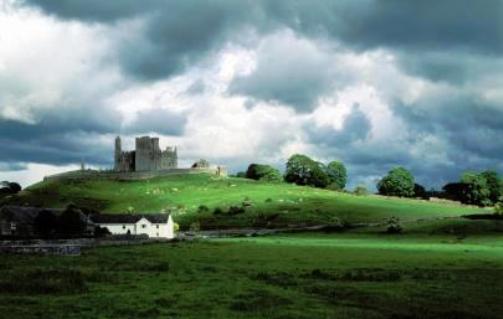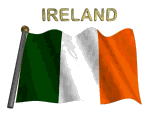|
|
 |
 |
|


|
|
|
IRELAND - A
brief history |
|
| |
|
| |
|
|
|
|
|
|
 |
 |
|
|
|
|
|
|
IRELAND [Ireland] Irish Eire [to it are related the poetic Erin and perhaps the Latin Hibernia ], island, 32,598 sq mi (84,429 sq km), second largest of the British
Isles. The island is divided into two major political
units—Northern Ireland (see Ireland, Northern ), which is joined with Great
Britain in the United Kingdom, and the Republic of Ireland (see Ireland, Republic of ). Of the 32 counties
of Ireland, 26 lie in the Republic, and
of the four historic provinces, three and part of the fourth are in the Republic.
Ireland to the English Conquest
The earliest known people in Ireland belonged to the
groups that inhabited all of the British Isles in prehistoric times. In the several centuries
preceding the birth of Jesus a number of Celtic tribes invaded and conquered Ireland
and established their distinctive culture (see Celt ), although they do not seem to have come in great
numbers. Ancient Irish legend tells of four successive peoples who invaded the country—the Firbolgs, the Fomors, the Tuatha De Danann, and the Milesians. Oddly enough, the Romans,
who occupied Britain for 400 years, never came to Ireland,
and the Anglo-Saxon invaders of Britain, who largely replaced the Celtic
population there, did not greatly affect Ireland.
Until the raids of the Norse in the late 8th cent., Ireland remained relatively untouched by foreign incursions and enjoyed the golden
age of its culture. The people, Celtic and non-Celtic alike, were organized into clans, or tribes, which in the early period
owed allegiance to one of five provincial kings—of
Ulster, Munster, Connacht, Leinster, and Meath (now the northern part of Leinster). These kings nominally
served the high king of all Ireland at Tara
(in Meath). The clans fought constantly among themselves, but despite civil strife, literature and art were held in high respect.
Each chief or king kept an
official poet (Druid) who preserved the oral traditions of the people. The Gaelic language and culture were extended into
Scotland by Irish emigrants in the 5th
and 6th cent.
Parts of Ireland had already been Christianized before the arrival of St. Patrick in the 5th cent., but pagan tradition continued to
appeal to the imagination of Irish poets even after the complete conversion of the country. The Celtic Christianity of Ireland produced many scholars and missionaries who traveled to England and the Continent, and it attracted students to Irish monasteries, until
the 8th cent. perhaps the most brilliant of Europe. St. Columba and St. Columban were among the most famous of Ireland's missionaries. All the arts flourished; Irish illuminated manuscripts
were particularly noteworthy. The Book of Kells (see Ceanannus Mór ) is especially famous.
The country did not develop a strong central government, however, and it was not
united to meet the invasions of the Norse, who settled on the shores of the island late in the 8th cent., establishing trading
towns (including Dublin, Waterford, and Limerick)
and creating new petty kingdoms. In 1014,
at Clontarf, Brian Boru, who had become high king
by conquest in 1002, broke the strength of the Norse invaders. There followed a period of 150 years during which Ireland was free from foreign interference but was torn by
clan warfare.
Ireland and the English
In the 12th cent., Pope Adrian IV
granted overlordship of Ireland to Henry II of England. The English conquest of Ireland was begun by Richard de Clare, 2d earl of Pembroke, known as Strongbow, who
intervened in behalf of a claimant to the throne of Leinster; in 1171, Henry himself went to Ireland, temporarily establishing
his overlordship there. With this invasion commenced an Anglo-Irish struggle that continued for nearly 800 years.
The
English established themselves in Dublin. Roughly a century
of warfare ensued as Ireland was divided into English shires ruled from
Dublin, the domains of feudal magnates who acknowledged English
sovereignty, and the independent Irish kingdoms. Many English intermarried with the Irish and were assimilated into Irish
society. In the late 13th cent. the English introduced a parliament in Ireland.
In 1315, Edward Bruce of Scotland invaded Ireland and was joined by many Irish kings. Although Bruce
was killed in 1318, the English authority in Ireland was weakening, becoming
limited to a small district around Dublin known as the Pale ; the rest of the country
fell into a struggle for power among the ruling Anglo-Irish families and Irish chieftains.
English attention was diverted by the Hundred Years War with France
(1337-1453) and the Wars of the Roses (1455-85). However, under Henry VII new interest in
the island was aroused by Irish support for Lambert Simnel, a Yorkist pretender to the English throne. To crush this support, Henry sent to Ireland
Sir Edward Poynings, who summoned an Irish
Parliament at Drogheda and forced it to pass the legislation known as Poynings' Law (1495).
These acts provided that future Irish Parliaments and legislation receive prior approval from the English Privy Council. A
free Irish Parliament was thus rendered impossible.
The English Reformation under Henry VIII gave rise in England to increased fears of foreign, Catholic invasion; control of Ireland thus became even more imperative. Henry VIII put down a rebellion (1534-37),
abolished the monasteries, confiscated lands, and established a Protestant "Church
of Ireland" (1537). But since the vast majority of Irish remained Roman
Catholic, the seeds of bitter religious contention were added to the already rancorous Anglo-Irish relations. The Irish rebelled
three times during the reign of Elizabeth I and were brutally suppressed. Under James I, Ulster was settled by Scottish and English Protestants, and many of the Catholic
inhabitants were driven off their lands; thus two sharply antagonistic communities were established.
Another Irish rebellion, begun in 1641 in reaction to the hated rule of
Charles I's deputy, Thomas Wentworth, earl of Strafford, was crushed (1649-50)
by Oliver Cromwell with the loss of hundreds of thousands of lives. More land was confiscated (and often given to absentee
landlords), and more Protestants settled in Ireland.
The intractable landlord-tenant problem that plagued Ireland
in later centuries can be traced to the English confiscations of the 16th and 17th cent.
Irish Catholics rallied to
the cause of James II after his overthrow (1688) in
England (see the Glorious Revolution ), while the Protestants in Ulster enthusiastically supported William III. At the battle of the Boyne (1690) near Dublin,
James and his French allies were defeated by William. The English-controlled Irish Parliament
passed harsh Penal Laws designed to keep the Catholic
Irish powerless; political equality was also denied to Presbyterians. At the same time English trade policy depressed the
economy of Protestant Ireland, causing many so-called Scotch-Irish to emigrate
to America. A newly flourishing woolen
industry was destroyed when export from Ireland
was forbidden.
During the American Revolution, fear of a French invasion of Ireland led Irish Protestants to form (1778-82) the Protestant Volunteer Army. The Protestants, led by Henry
Grattan, and even supported by
some Catholics, used their military strength to extract concessions for Ireland
from Britain. Trade concessions were granted
in 1779, and, with the repeal of Poynings' Law (1782), the Irish Parliament had its independence restored. But the Parliament
was still chosen undemocratically, and Catholics continued to be denied the right to hold political office.
Another
unsuccessful rebellion was staged in 1798 by Wolfe Tone, a Protestant who had formed the Society of United Irishmen and who accepted French aid in the uprising. The reliance
on French assistance revived anti-Catholic feeling among the Irish Protestants, who remembered French support of the Jacobite restoration. The rebellion convinced the British prime minister, William Pitt, that the Irish problem could be solved by the adoption
of three policies: abolition of the Irish Parliament, legislative union with Britain in a
United Kingdom of Great Britain and Ireland, and Catholic Emancipation. The first two goals were achieved in 1800, but the
opposition of George III and British Protestants prevented the enactment of the Catholic Emancipation Act until 1829, when
it was accomplished largely through the efforts of the Irish leader Daniel O'Connell.
Ireland under the Union
After 1829 the Irish representatives in the British Parliament attempted
to maintain the Irish question as a major issue in British politics. O'Connell worked to repeal the union with Britain, which was felt to operate to Ireland's
disadvantage, and to reform the government in Ireland.
Toward the middle of the century, the Irish Land Question grew increasingly urgent. But the Great Potato Famine
(1845-49), one of the worst natural disasters in history, dwarfed political developments. During these years a blight ruined
the potato crop, the staple food of the Irish population, and hundreds of thousands perished from hunger and disease. Many
thousands of others emigrated; between 1847 and 1854 about 1.6 million went to the United States. The population dropped from an estimated 8.5 million in 1845 to
6.55 million in 1851 (and continued to decline until the 1960s). Irish emigrants in America formed the secret Fenian movement, dedicated to Irish independence.
In 1869 the British prime minister William Gladstone sponsored an act disestablishing the Protestant "Church of Ireland" and thereby removed one
Irish grievance.
In the 1870s, Irish politicians renewed efforts to achieve Home Rule within the union, while in Britain Gladstone and others attempted to solve the Irish problem through land
legislation and Home Rule. Gladstone twice submitted Home
Rule bills (1886 and 1893) that failed. The proposals alarmed Protestant Ulster,
which began to organize against Home Rule. In 1905,
Arthur Griffith founded Sinn Féin among Irish Catholics, but for the time being the dominant
Irish nationalist group was the Home Rule party of John
Redmond.
Home Rule was finally enacted in 1914, with the provision that Ulster
could remain in the union for six more years, but the act was suspended for the duration of World War I and never went into
effect. In both Ulster and Catholic Ireland militias were formed. The Irish Republican Brotherhood, a descendent of
the Fenians, organized a rebellion on Easter Sunday, 1916; although unsuccessful, the rising acquired great propaganda value
when the British executed its leaders.
Sinn Fein, linked in the Irish
public's mind with the rising and aided by Britain's attempt to apply conscription to Ireland, scored a tremendous victory
in the parliamentary elections of 1918. Its members refused to take their seats in Westminster,
declared themselves the Dáil Éireann (Irish Assembly), and proclaimed an Irish
Republic. The British outlawed both Sinn Fein and the Dáil, which went
underground and engaged in guerrilla warfare (1919-21) against local Irish authorities representing the union. The British
sent troops, the Black and Tans, who inflamed the situation further. |
|

